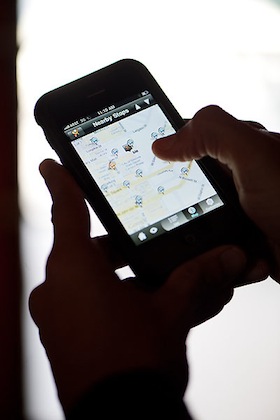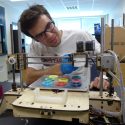UW students go mobile, portable and functional with their computing
As their computing devices become smaller, UW–Madison students are raising their online expectations. Internet-ready handheld devices and tablet computers are growing in popularity on campus, and students want more from them in terms of features, apps and tools for learning and communicating.

Two-thirds of students responding to the annual DoIT survey said they owned a smart phone or other Internet-ready handheld mobile device — up from 56 percent a year ago.
Photo: Jeff Miller
These and other findings come from the 2012 Student Computing Survey conducted by UW–Madison’s Division of Information Technology (DoIT). The yearly survey tracks students’ computing preferences and their use of UW computing services over time, detects emerging trends, measures levels of awareness, and analyzes demand for new and existing services.
UW-Madison students are setting aside their desktop computers in favor of smaller, more portable computing options. Two-thirds of students responding to the survey said they owned an Internet-ready, handheld mobile device, such as a smart phone, iPhone, BlackBerry, Palm, Android, or iPod touch. This is up from 56 percent in the 2011 survey and 45 percent in 2010. Meanwhile, ownership of simple cell phones declined to 35 percent, down from 49 percent in 2011 and 62 percent in 2010.
Almost all students (97 percent) own a laptop computer, while only 36 percent own a desktop device, down from 45 percent in 2011. The use of tablet computers, such as iPads, Kindles, and NOOKs, is small but growing. Twenty-four percent of students own one, compared to 11 percent in 2011. Almost 75 percent of students use flash drives or other portable data storage to transport information for sharing or study.

The use of tablet computers on campus has more than doubled over the past year, according to the DoIT survey.
Photo: Jeff Miller
Students are relying more heavily on the Web-based technologies available with their computing devices. Ninety-eight percent use Learn@UW, UW–Madison’s course management system, for coursework and collaboration. Almost 40 percent use an online calendar to manage their busy lives. For academic, work, or personal tasks, students use social networking sites such as Facebook, Twitter, and LinkedIn (91 percent), YouTube (91 percent), Web-based commercial email (85 percent), and video calling or Internet long-distance services (77 percent). Seventy percent use location-based services, such as Facebook Places, Google Maps, foursquare and Yelp, to share their whereabouts and activities with friends and learn more about nearby services. That is up from 60 percent in 2011.
And they want more. Mobile UW, the official campus app for iPhone and Android phones, is widely popular, but students asked for more features in the app. That includes more administrative services, mobile access to course and enrollment functions, cash management and payment options, and library services.
Students also asked for more discounts on hardware and software, access to electronic textbooks, and more video capture of lectures. They want more help with online security and virus protection. Many called for UW–Madison to provide and manage cloud-based services for email, data storage and calendaring.
With more reliance on Internet tools and services comes a heightened risk to online security. Most students are aware of these risks and take action to avoid them, but gaps remain. A quarter of students, for example, do not have anti-virus/antispyware software installed on their computers, and only a third update their computer’s operating system on a regular basis.
Students are generally satisfied with their computing services at UW–Madison. Examples include:
- Learn@UW course management system: 84%
- UW wireless network: 81%
- DoIT Help Desk: 79%
- WISC software discounts: 77%
- General-access computer labs: 67%
Other survey findings:
- In computer labs where students have a choice of operating systems, 40 percent choose Windows, and 25 percent prefer Macintosh.
- Reported use of Internet-enabled gaming consoles (Xbox 360, Wii, PlayStation3, etc.) was 31 percent, similar to the 30 percent reported in 2011.
- Most students are aware of copyright infringement and the penalties for downloading material illegally. Most know that they could inadvertently share their music files by installing file-sharing programs such as LimeWire, BitTorrent, etc. But 44 percent also say they use file-sharing software to download music or other files.
The annual UW–Madison Student Computing Survey was delivered on the Web in spring 2012 using a random sample of 1,200 UW–Madison undergraduate, graduate, professional and special students, of whom 316 responded. The response rate was 26 percent. The full report — as well as a similar report on faculty and staff — is available here.
Tags: computers, learning, students, technology


